Java--算法--常用的10种算法
- 非递归的二分查找算法:
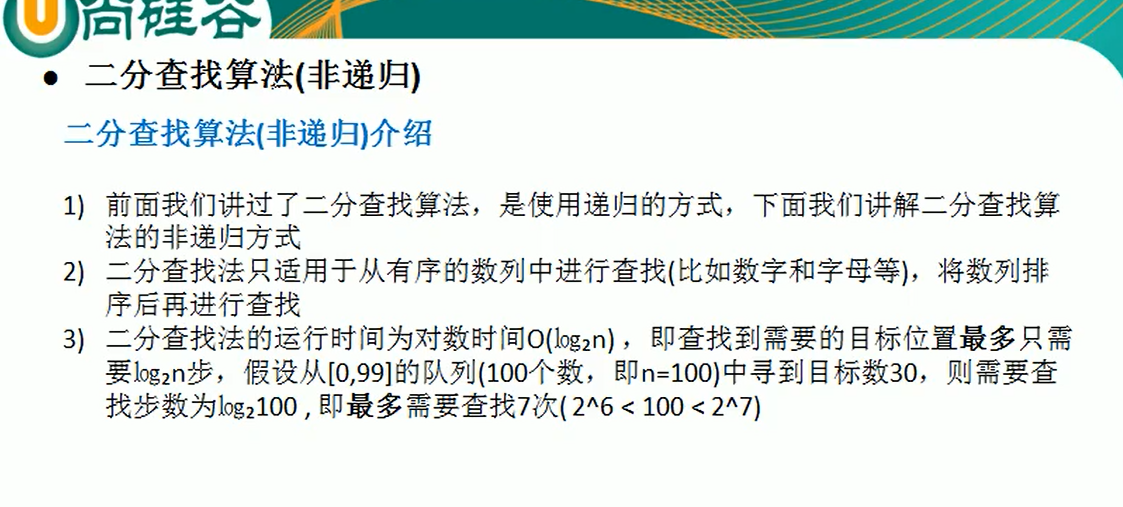

-
package com.model.algorithm; /** * @Description:测试类 * @Author: 张紫韩 * @Crete 2021/7/17 20:04 * 常用的算法---非递归式的二分查找算法 */ public class AlgorithmDemo01 { public static void main(String[] args) { int[] array={1,2,3,4,5,6,7,8,9}; System.out.println("index="+binarySearch(array, 5)); } public static int binarySearch(int[] array,int targetNum){ if (array.length !=0) { int left = 0; int right = array.length; int mid; while (left <= right) { mid = (left + right) / 2; if (targetNum > array[mid]) { left = mid + 1; } else if (targetNum < array[mid]) { right = mid - 1; } else { return mid; } } } return -1; } }
-
分治算法:
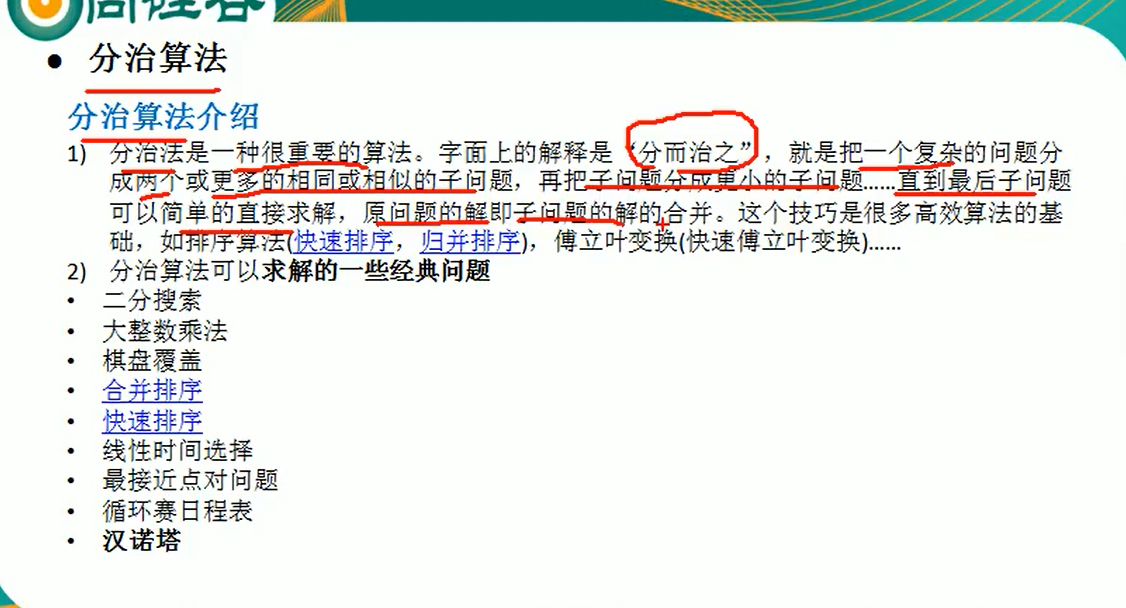
-

-
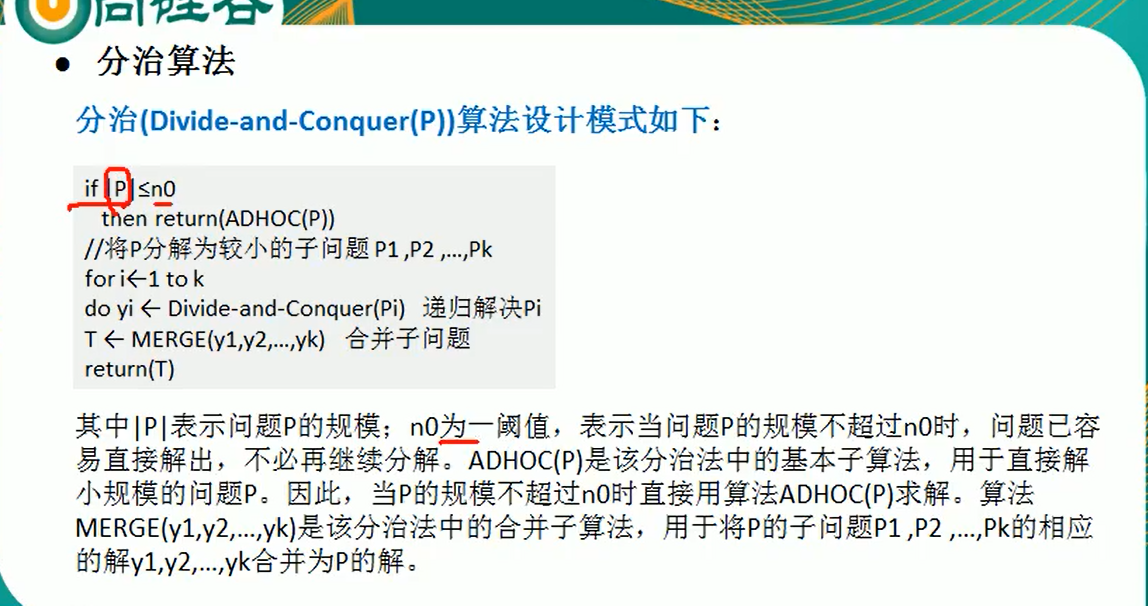
-
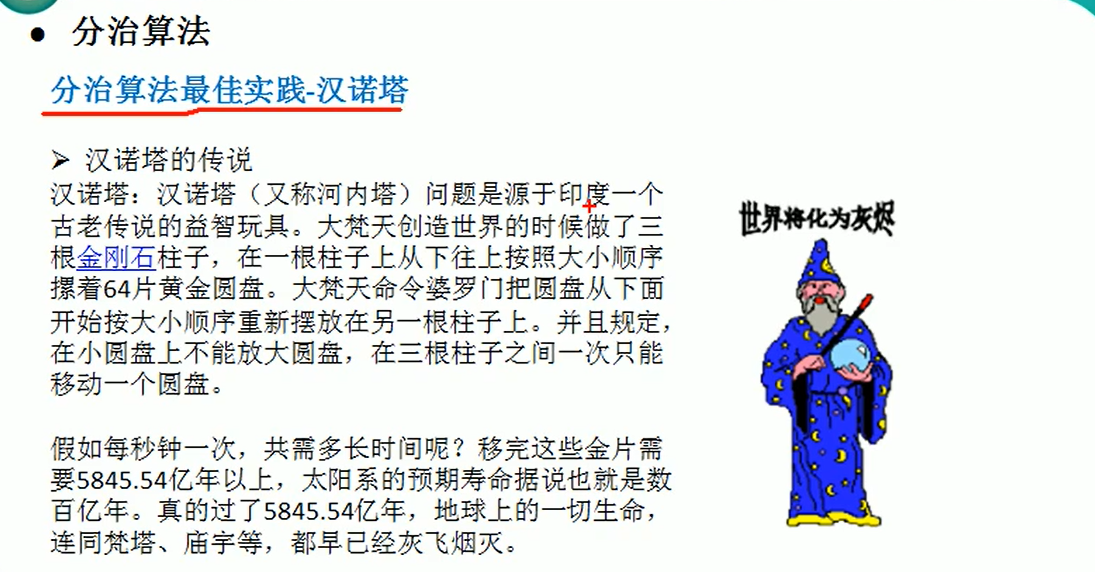
-
package com.model.algorithm; /** * @Description:测试类 * @Author: 张紫韩 * @Crete 2021/7/17 21:14 * 常用算法---分治算法 * 汉诺塔 */ public class AlgorithmDemo02 { public static void main(String[] args) { hanoiTower(4, 'A', 'B', 'C'); } public static void hanoiTower(int num,char one,char two,char three){ if (num==1){ System.out.println("移动第"+num+"盘"+one+"->"+three); }else { hanoiTower(num-1, one, three, two); System.out.println("移动第"+num+"盘"+one+"->"+three); hanoiTower(num-1, two, one, three); } } }
-
动态规划算法:
-
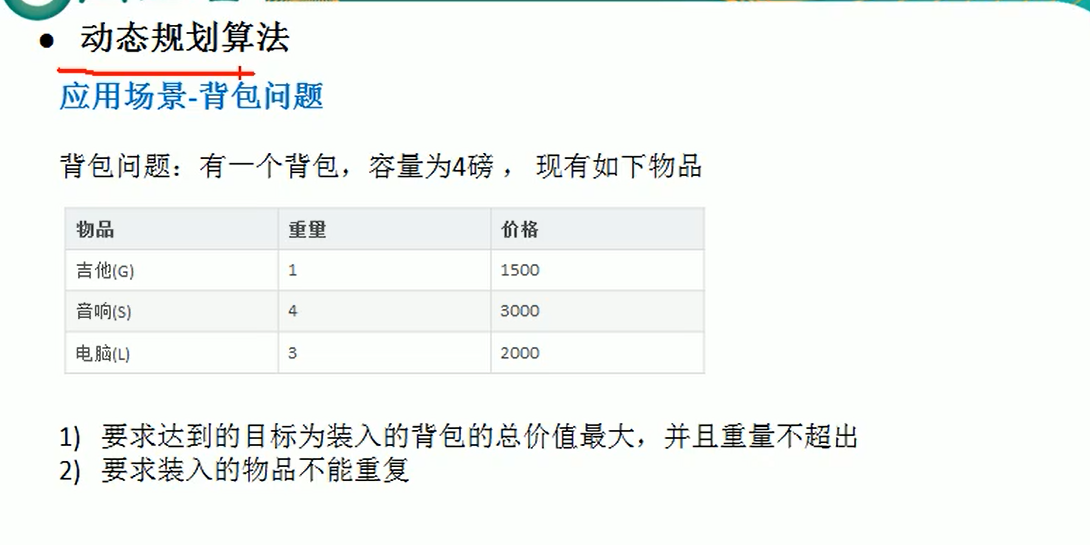
-
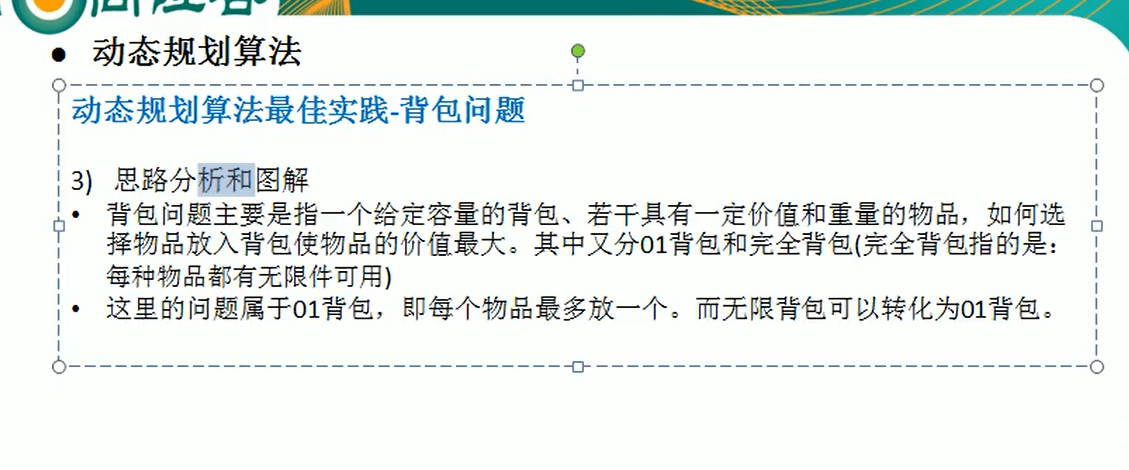
-
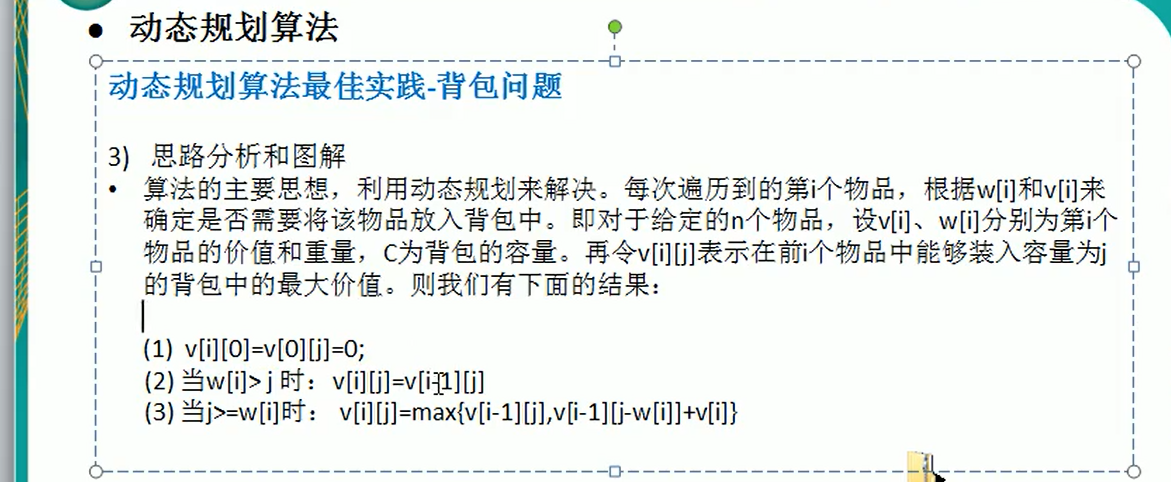
-

-
package com.model.algorithm; /** * @Description:测试类 * @Author: 张紫韩 * @Crete 2021/7/18 10:51 * 十种常用算法--动态规划算法 */ public class AlgorithmDemo03 { public static void main(String[] args) { int[] value = {0, 1500, 3000, 2000}; int[] weight = {0, 1, 4, 3}; int m = 4;//背包的重量 int[][] res = new int[value.length][m + 1]; int[][] path = new int[value.length][m + 1]; // 初始化 for (int i = 0; i < res.length; i++) {//第一列的,重量为0 res[i][0] = 0; } for (int i = 0; i < res[0].length; i++) { res[0][i] = 0; } for (int i = 1; i < res.length; i++) { for (int j = 1; j < res[0].length; j++) { if (weight[i] > j) { res[i][j] = res[i - 1][j]; } else { if (value[i]+res[i-1][j-weight[i]]>res[i-1][j]){ res[i][j]=value[i] + res[i - 1][j - weight[i]]; path[i][j]=1; }else { res[i][j]=res[i-1][j]; } } } } for (int i = 0; i < res.length; i++) { for (int j = 0; j < res[0].length; j++) { System.out.print(res[i][j] + "\t"); } System.out.println(); } int i = path.length-1; int j=path[0].length-1; while(i>=0&&j>=0){ if (path[i][j]==1){ System.out.printf("第%d个物品放入了背包\n",i); j-=weight[i]; } i--; } } }
-
-
KMP算法:
-
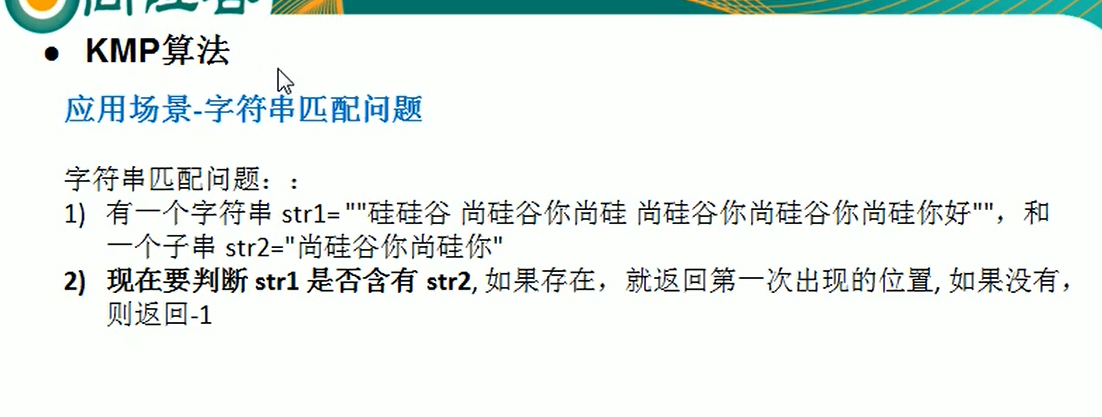
-
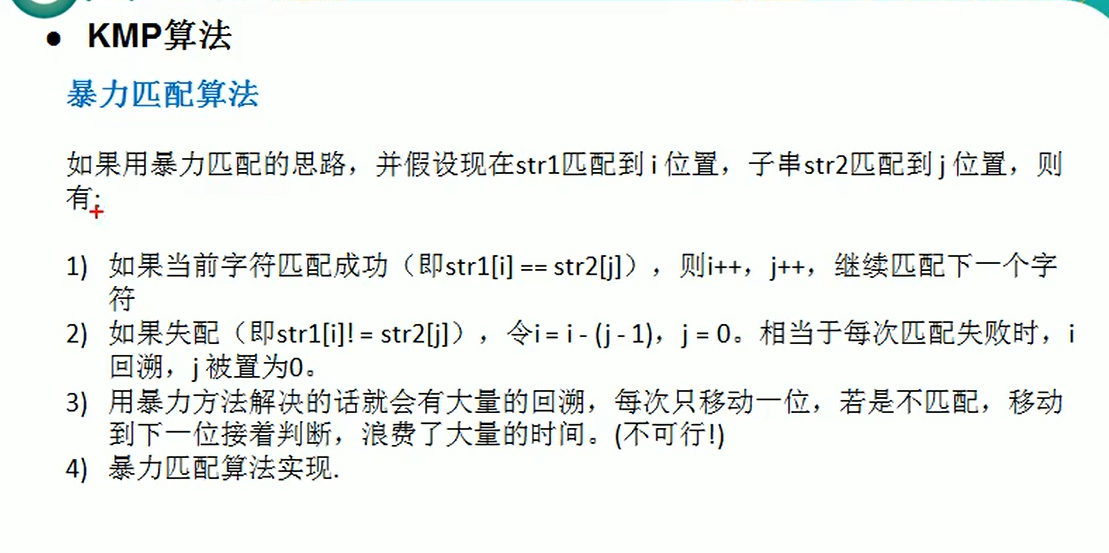
-
package com.model.algorithm; /** * @Description:测试类 * @Author: 张紫韩 * @Crete 2021/7/18 16:38 * 十种常用算法---KMP算法 */ public class AlgorithmDemo04 { public static void main(String[] args) { String str2="wxiz"; String str1="aaawxiz"; System.out.println(math01(str1, str2)); } // 暴力匹配,str1中是否包含str2 public static boolean math(String str1,String str2){ for (int i = 0; i < str1.length()-str2.length()+1; i++) { int length = str2.length(); if (str2.equals(str1.substring(i, i+length))){ return true; } } return false; } public static int math01(String str1,String str2){ int i=0; int j=0; char[] char1 = str1.toCharArray(); char[] char2 = str2.toCharArray(); int len1=char1.length; int len2=char2.length; while(i<len1&&j<len2){ if (char1[i]==char2[j]){ i++; j++; }else { i=i-j+1; j=0; } } if (j==len2){ return i-j; }else { return -1; } } }
-

-
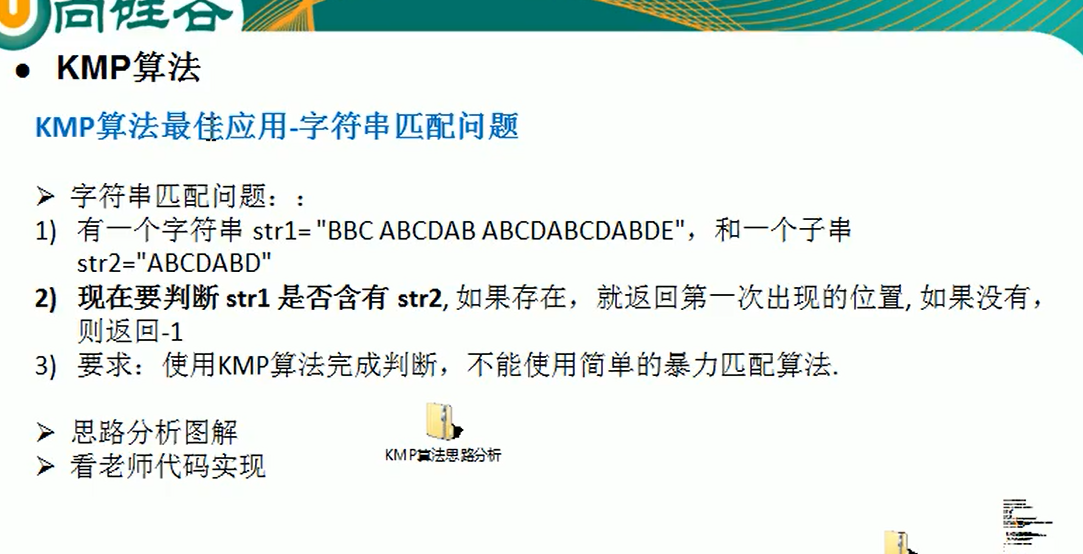
-

-
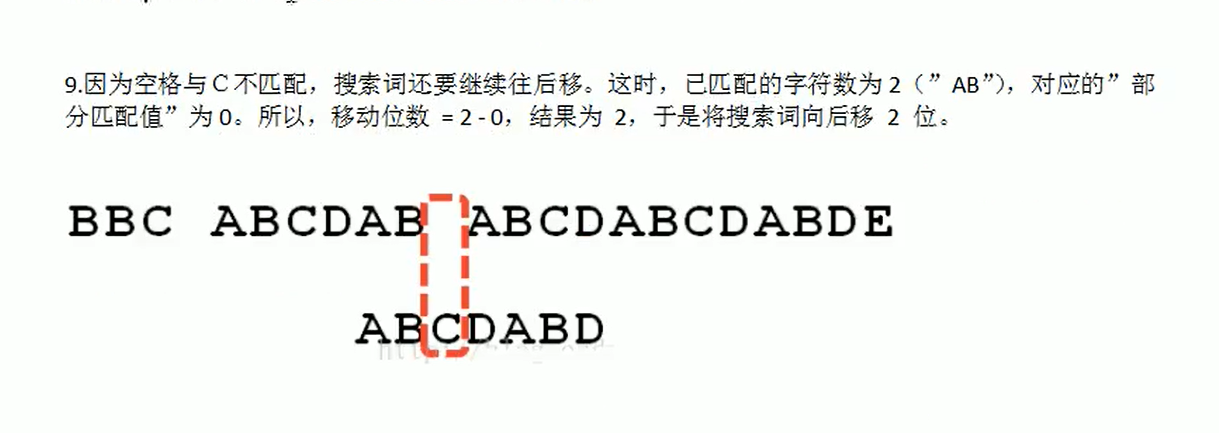
-
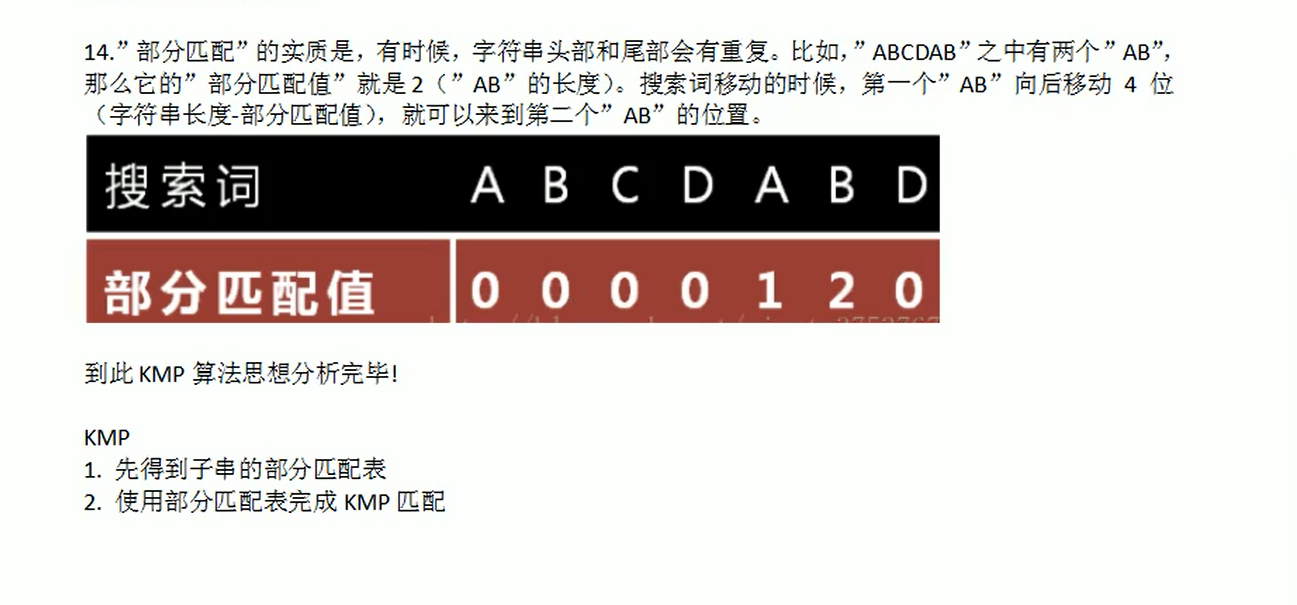
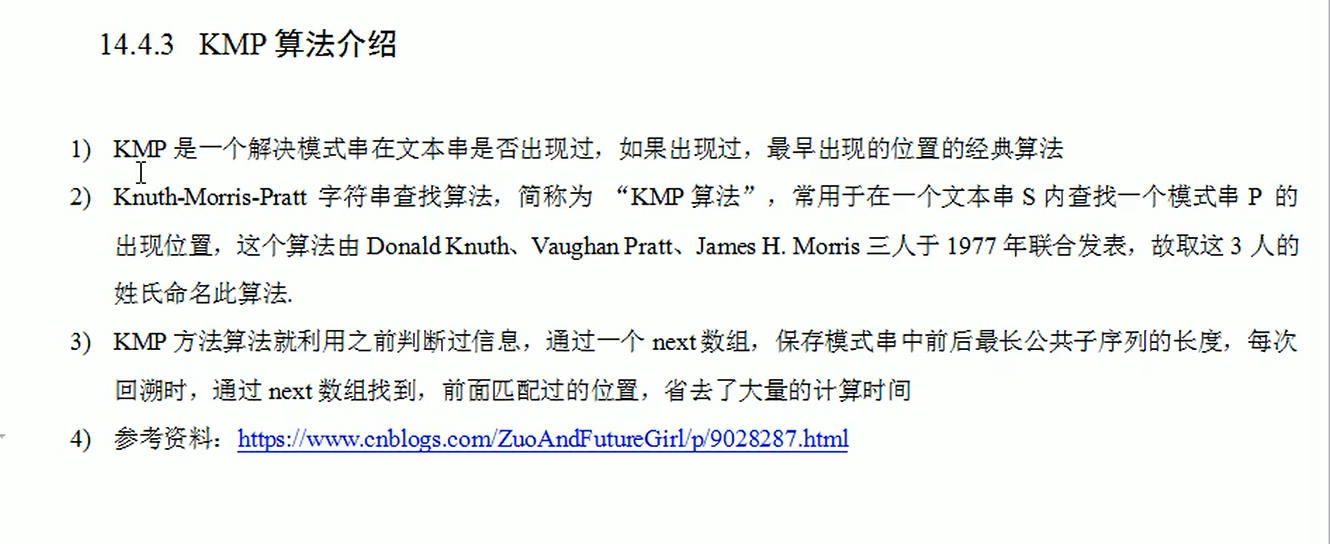
-
package com.model.algorithm; import java.util.Arrays; /** * @Description:测试类 * @Author: 张紫韩 * @Crete 2021/7/18 16:38 * 十种常用算法---KMP算法(字符串匹配问题) */ public class AlgorithmDemo04 { public static void main(String[] args) { System.out.println("暴力匹配算法"); String str2 = "wxiz"; String str1 = "aaawxiz"; System.out.println(math01(str1, str2)); System.out.println("KMP算法的使用"); String string1 = "BBC ABCDAB ABCDABDABDE"; String string2 = "ABCDABD"; System.out.println(Arrays.toString(kmpNext(string2))); int[] kmpNext = kmpNext(string2); System.out.println(kmpSearch(string1, string2, kmpNext)); } // KMP搜索算法 public static int kmpSearch(String str1, String str2, int[] next) { int j = 0; int len2 = str2.length(); for (int i = 0; i < str1.length(); i++) { if (str1.charAt(i) == str2.charAt(j)) { j++; } // KMP算法的核心,调整j的位置 while (j > 0 && str1.charAt(i) != str2.charAt(j)) { j = next[j - 1]; } if (j == len2) { return i - j + 1; } } return -1; } // kmp算法得到一个字符串的部分匹配表 public static int[] kmpNext(String str) { int[] next = new int[str.length()]; next[0] = 0;//如果字符串的长度是1返回的部分匹配之就是0 for (int i = 1, j = 0; i < str.length(); i++) { // 当匹配到str.charAt(i)!=str.charAt(j)满足时,我们需要从 next[j-1]获取新的j的值, // 知道我们发现str.charAt(i)==str.charAt(j)成立才退出 // 这时KMP的核心语法 while (j > 0 && str.charAt(i) != str.charAt(j)) { j = next[j - 1]; } // 当匹配到str.charAt(i)==str.charAt(j)满足时,部分匹配表就+1 if (str.charAt(i) == str.charAt(j)) { j++; } next[i] = j; } return next; } // 暴力匹配,str1中是否包含str2 public static boolean math(String str1, String str2) { for (int i = 0; i < str1.length() - str2.length() + 1; i++) { int length = str2.length(); if (str2.equals(str1.substring(i, i + length))) { return true; } } return false; } public static int math01(String str1, String str2) { int i = 0; int j = 0; char[] char1 = str1.toCharArray(); char[] char2 = str2.toCharArray(); int len1 = char1.length; int len2 = char2.length; while (i < len1 && j < len2) { if (char1[i] == char2[j]) { i++; j++; } else { i = i - j + 1; j = 0; } } if (j == len2) { return i - j; } else { return -1; } } }
-
-
贪心算法:
-
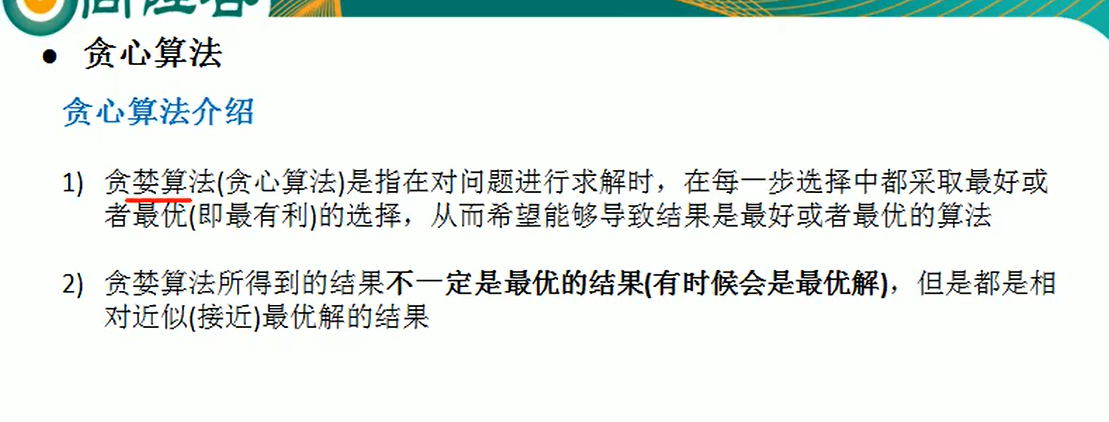
-
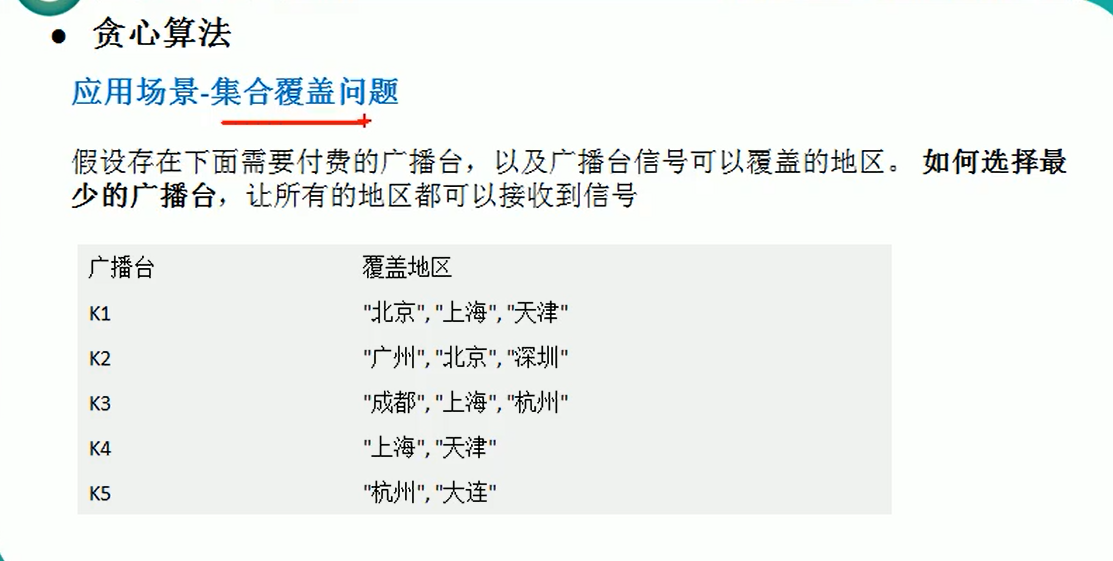

-

-
package com.model.algorithm; import org.w3c.dom.stylesheets.LinkStyle; import java.util.*; /** * @Description:测试类 * @Author: 张紫韩 * @Crete 2021/7/19 15:18 * 十种常用算法--贪心算法 * 集合覆盖问题 */ public class AlgorithmDemo05 { public static void main(String[] args) { HashMap<String, HashSet<String>> broadcasts = new HashMap<>(); HashSet<String> set1 = new HashSet<>(); set1.add("北京"); set1.add("上海"); set1.add("天津"); HashSet<String> set2 = new HashSet<>(); set2.add("广州"); set2.add("北京"); set2.add("深圳"); HashSet<String> set3 = new HashSet<>(); set3.add("成都"); set3.add("上海"); set3.add("杭州"); HashSet<String> set4 = new HashSet<>(); set4.add("上海"); set4.add("天津"); HashSet<String> set5 = new HashSet<>(); set5.add("杭州"); set5.add("大连"); broadcasts.put("k1", set1); broadcasts.put("k2", set2); broadcasts.put("k3", set3); broadcasts.put("k4", set4); broadcasts.put("k5", set5); HashSet<String> allAreas=new HashSet<>(); allAreas.add("北京"); allAreas.add("上海"); allAreas.add("广州"); allAreas.add("天津"); allAreas.add("深圳"); allAreas.add("杭州"); allAreas.add("大连"); allAreas.add("成都"); // System.out.println("覆盖最多未选择城市广播的名称:"+getMaxBroadcast(allAreas, broadcasts)); ArrayList<String> list = greedy(broadcasts, allAreas); for (String key:list){ System.out.print(key+"\t"); } } public static ArrayList<String> greedy(HashMap<String,HashSet<String>> broadcasts,HashSet<String> allAreas){ ArrayList<String> resList = new ArrayList<>();//存放结果,包含所有的城市的电台组合 while(!(allAreas.isEmpty())){ String res = getMaxBroadcast(allAreas, broadcasts); // 清除掉所有的已经覆盖的城市 // HashSet<String> citySet = broadcasts.get(res); // for (String city:citySet){ // allAreas.remove(city); // } allAreas.removeAll(broadcasts.get(res)); resList.add(res); } return resList; } // 遍历获取到各个广播台的覆盖未选城市个数,返回第一个覆盖为选城市的电台 public static String getMaxBroadcast(HashSet<String> allAreas,HashMap<String,HashSet<String>> broadcasts){ int max=Integer.MIN_VALUE; String resName=null; for ( Map.Entry<String, HashSet<String>> entrySet:broadcasts.entrySet()){ String key = entrySet.getKey(); HashSet<String> value = entrySet.getValue(); int count=0; value.retainAll(allAreas); count=value.size(); // for (String city:value){ // if (allAreas.contains(city)){ // count++; // } // } if (count>max){ max=count; resName=key; } } return resName; } }
-
-
普利姆算法:
-
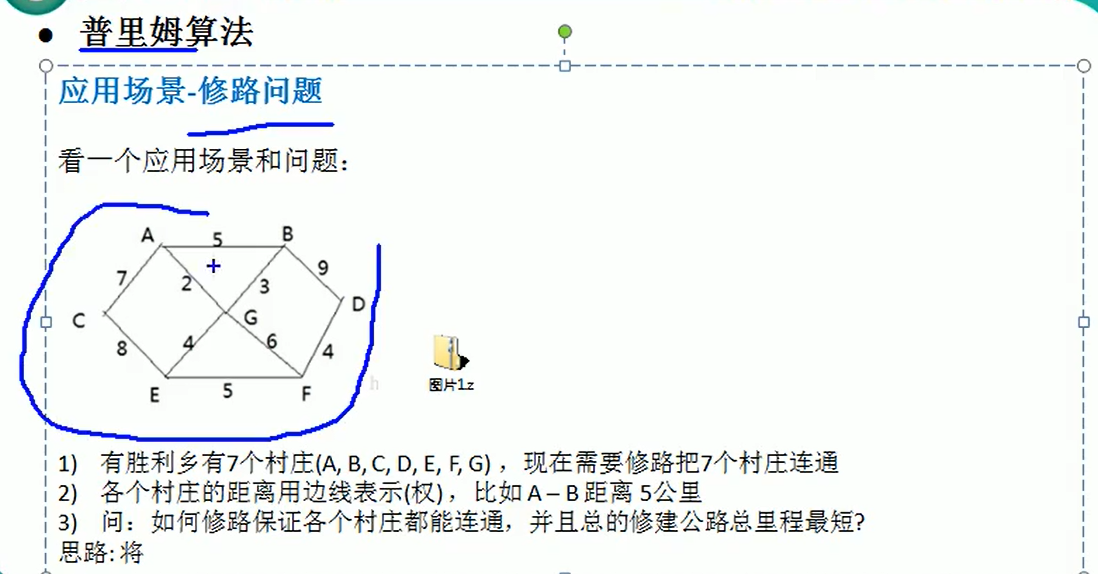
-

-
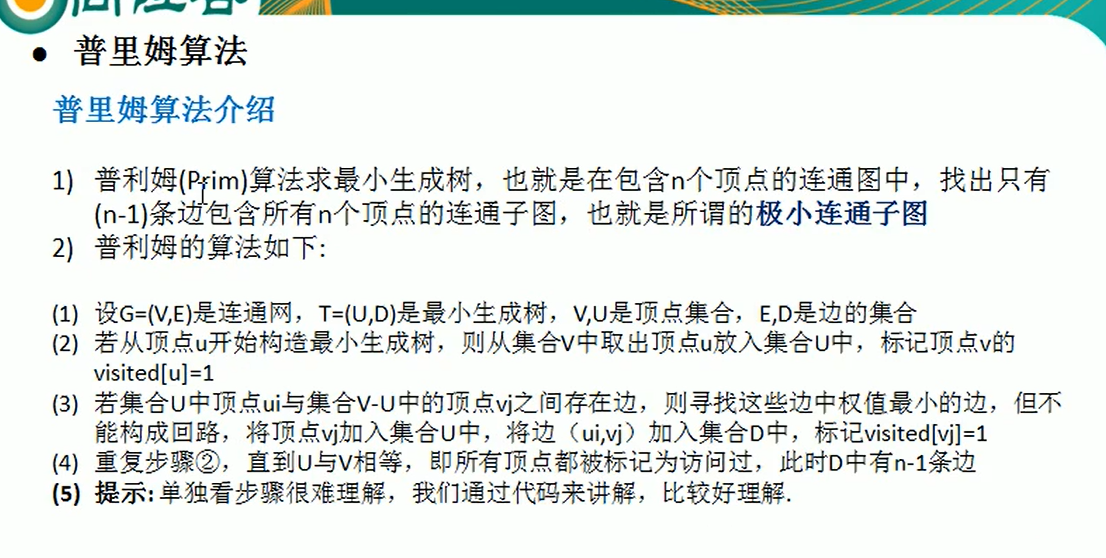
-
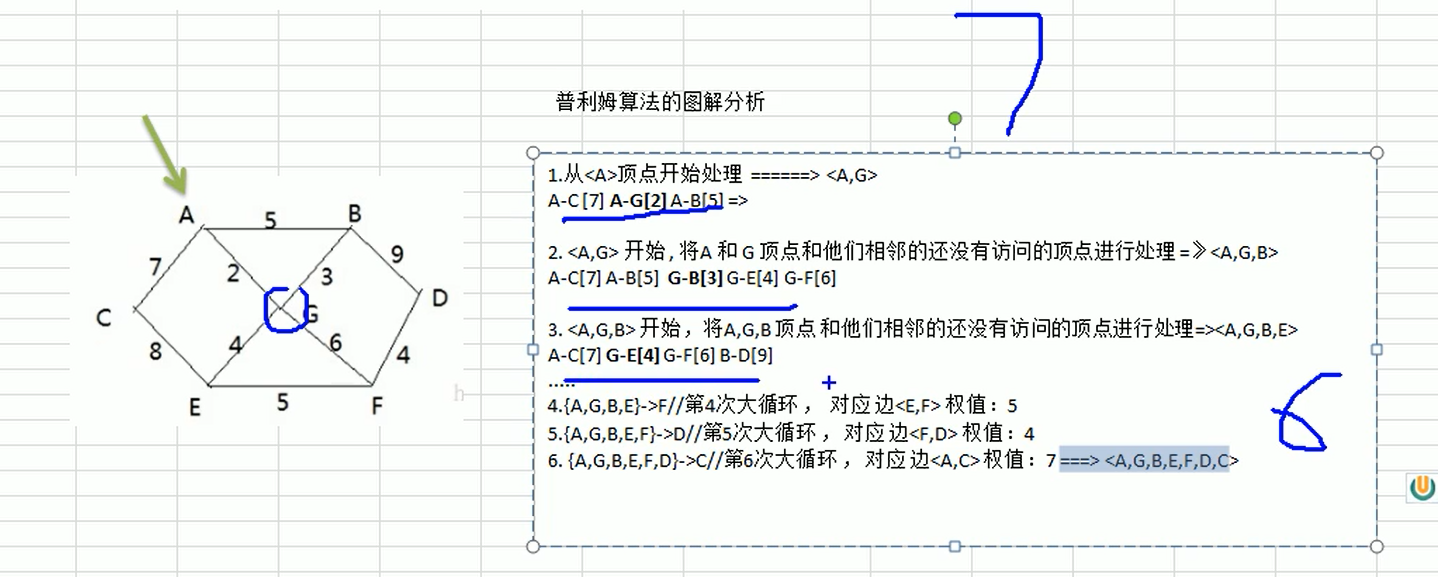
-
package com.model.algorithm; import java.util.Arrays; /** * @Description:测试类 * @Author: 张紫韩 * @Crete 2021/7/19 17:26 * 十种常用算法--普利姆算法(Prim) */ public class AlgorithmDemo06 { public static void main(String[] args) { char[] data={'A','B','C','D','E','F','G'}; Graph graph = new Graph(data); graph.addSize('A', 'B', 5); graph.addSize('A', 'C', 7); graph.addSize('A', 'G', 2); graph.addSize('B', 'G', 3); graph.addSize('B', 'D', 9); graph.addSize('C', 'E', 8); graph.addSize('D', 'F', 4); graph.addSize('E', 'F', 5); graph.addSize('E', 'G', 4); graph.addSize('F', 'G', 6); // graph.show(); MinTree minTree = new MinTree(graph); minTree.show(); minTree.createMinTree('A'); } } class MinTree{ private Graph graph; // 核心方法。使用图创建最小生成树 public void createMinTree(char c){ int start = graph.getNumber(c); int[] visited=new int[graph.nodeNum]; // 将当前节点标记未已经访问 visited[start]=1; // 找出 nodeNum-1条边 for (int i = 1; i < graph.nodeNum; i++) {//一共有 nodeNum-1条的边 int minWeight=1000; int x=-1; int y=-1; for (int j = 0; j < graph.nodeNum; j++) {//遍历已经访问的节点 for (int k = 0; k < graph.nodeNum; k++) {//遍历没有被访问过的节点 if (visited[j]==1&&visited[k]==0&&graph.weight[j][k]<minWeight){ minWeight=graph.weight[j][k]; x=j; y=k; } } } visited[y]=1; System.out.println("找到最小的一条边:<"+graph.data[x]+","+graph.data[y]+">\t权值是:"+minWeight); } } // 遍历图 public void show(){ if (graph!=null) { graph.show(); }else { System.out.println("图为空,无法进行遍历"); } } public MinTree(Graph graph) { this.graph = graph; } } class Graph{ int nodeNum;//节点的数量 char[] data;//存放节点的数据 int[][] weight;//存放边 public Graph(char[] data) { this.nodeNum = data.length; this.data=data; weight=new int[nodeNum][nodeNum]; for (int[] arr:weight) { Arrays.fill(arr, 1000); } } public void addSize(char nodeA,char nodeB,int weight){ this.weight[getNumber(nodeA)][getNumber(nodeB)]=weight; this.weight[getNumber(nodeB)][getNumber(nodeA)]=weight; } public void show(){ for (int[] link:this.weight){ System.out.println(Arrays.toString(link)); } } public int getNumber(char c){ switch (c){ case 'A': return 0; case 'B': return 1; case 'C': return 2; case 'D': return 3; case 'E': return 4; case 'F': return 5; case 'G': return 6; default: return -1; } } }
-
-
克鲁斯卡尔算法(Kruskal)
-
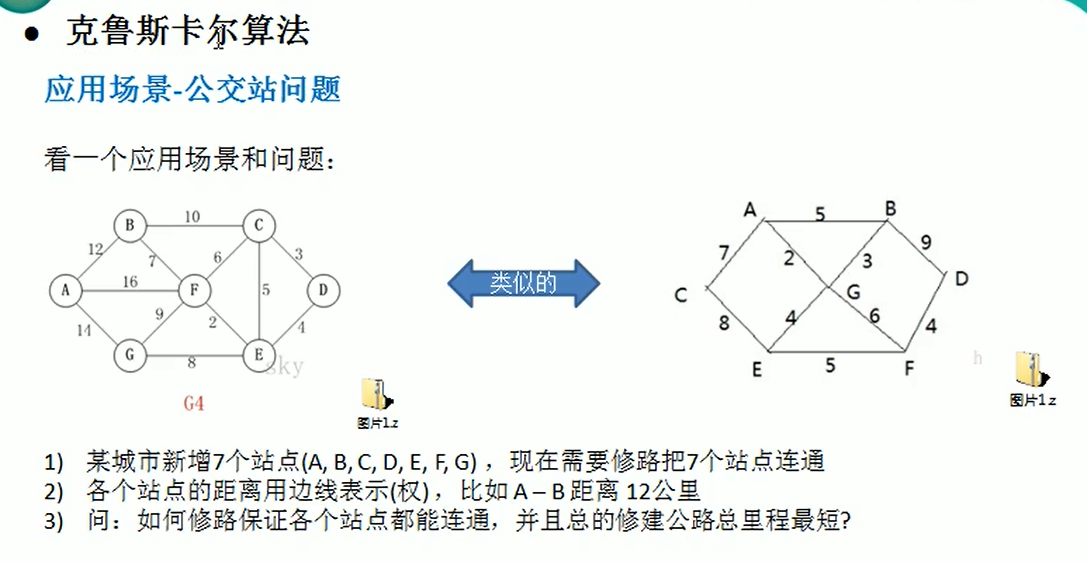
-

-

-
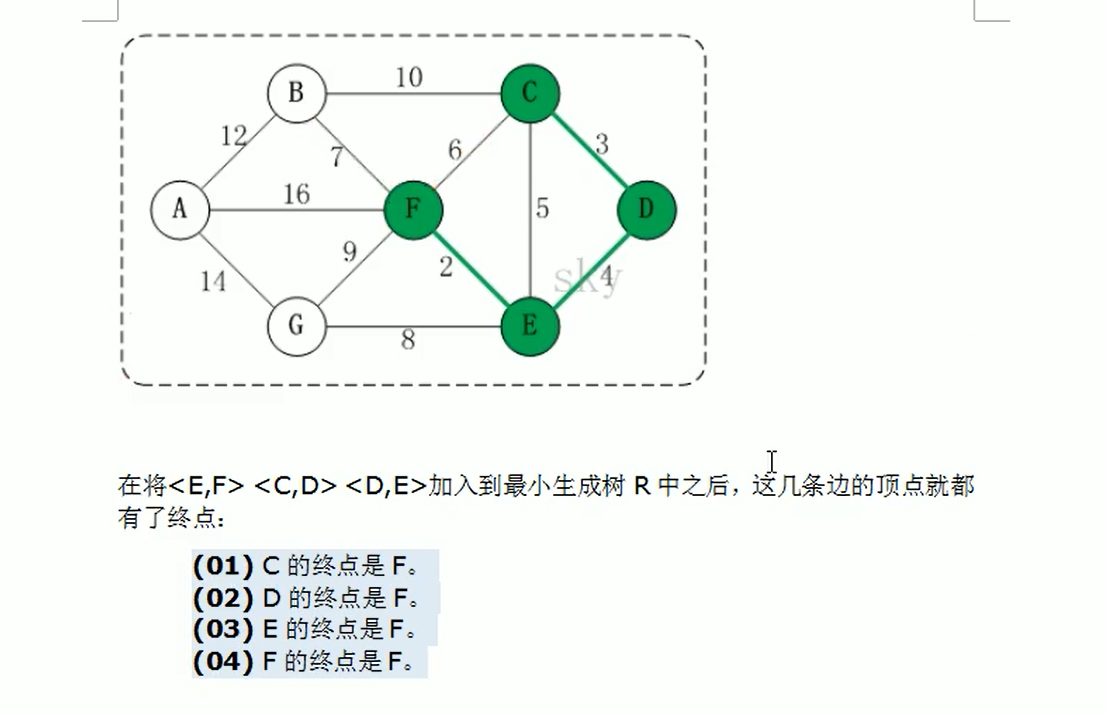
-
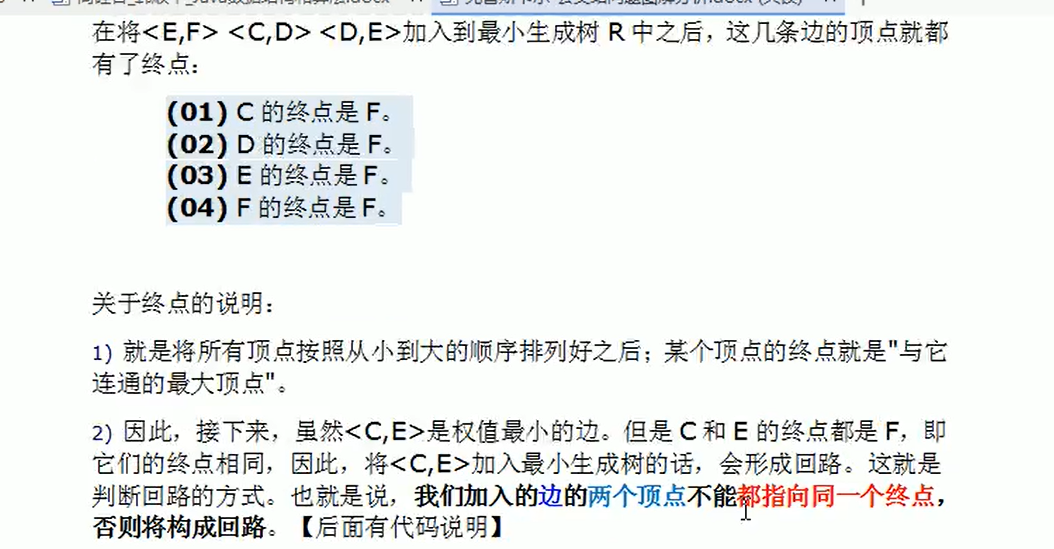
-
package com.model.algorithm; import java.util.Arrays; /** * @Description:测试类 * @Author: 张紫韩 * @Crete 2021/7/19 19:37 * 十种常用算法--克鲁斯卡尔算法(Kruskal) * 公交站问题 */ public class AlgorithmDemo07 { public static void main(String[] args) { char[] data = {'A', 'B', 'C', 'D', 'E', 'F', 'G'}; KruskalGraph graph = new KruskalGraph(data); graph.addSize('A', 'B', 12); graph.addSize('A', 'F', 16); graph.addSize('A', 'G', 14); graph.addSize('B', 'C', 10); graph.addSize('B', 'F', 7); graph.addSize('C', 'D', 3); graph.addSize('C', 'E', 5); graph.addSize('C', 'F', 6); graph.addSize('D', 'E', 4); graph.addSize('E', 'F', 2); graph.addSize('E', 'G', 8); graph.addSize('F', 'G', 9); // graph.show(); Kruskal kruskal = new Kruskal(graph); kruskal.show(); System.out.println("边的数量:" + kruskal.getEdgeNum()); KruskalEdge[] edges = kruskal.getEdge(); for (KruskalEdge edge : edges) { System.out.println(edge); } System.out.println("排序后的边:"); kruskal.sortEdge(edges); for (KruskalEdge edge : edges) { System.out.println(edge); } System.out.println("使用克鲁斯卡尔算法得到的最小生成树:"); kruskal.createGraph(); } } //克鲁斯卡尔生成最小生成树 class Kruskal { private KruskalGraph graph; //核心方法,使用kruskal算法生成最小生成树 public void createGraph() { int index=0;//表示结果数组的索引 int[] ends=new int[graph.nodeNum];//保存每个顶点的终点 KruskalEdge[] rets=new KruskalEdge[graph.nodeNum-1];//创建一个返回值 KruskalEdge[] edges=getEdge();//的到所有的边 // System.out.println(Arrays.toString(edges)); // 对边进行排序 sortEdge(edges); // 遍历edges边的数组,将最小的边添加到最小生成树,判断是否构成回路,如果没有就加入到,否则不加入 for (int i = 0; i < getEdgeNum(); i++) { //edges[i].getStart():edges[i]边的起点 int p1=getPosition(edges[i].getStart()); int p2=getPosition(edges[i].getEnd()); //ends:保存已经生成的最小生树每个顶点的终点 int end1=getEnd(ends, p1); int end2=getEnd(ends, p2); if (end1!=end2){ ends[end1]=end2; rets[index++]=edges[i]; } } // 输出所有的构成最小生成树的边 for (KruskalEdge edge:rets){ System.out.println(edge); } } // 返回顶点的坐标 public int getPosition(char c) { return graph.getPosition(c); } // 获取到所有的边 public KruskalEdge[] getEdge() { if (graph != null) { return graph.getEdge(); } else { return null; } } // 功能:获取小标未i的顶点的终点,用于后面判断两个顶点是否是相同的 // ends:数组记录了各个顶点对应的终点是那个, // i:表示传入的顶点对应的下标 // 返回的是 顶点i对应的终点的下标 public int getEnd(int[] ends,int i){ while (ends[i]!=0){ i=ends[i]; } return i; } // 对边进行排序 public void sortEdge(KruskalEdge[] Edges) { for (int i = 0; i < Edges.length; i++) { for (int j = 0; j < Edges.length - 1 - i; j++) { if (Edges[j].getWeight() > Edges[j + 1].getWeight()) { KruskalEdge temp = Edges[j]; Edges[j] = Edges[j + 1]; Edges[j + 1] = temp; } } } } // 获取边的数量 public int getEdgeNum() { if (graph != null) { return graph.getEdgeNum(); } else { return -1; } } // 遍历图 public void show() { if (graph != null) { graph.show(); } else { System.out.println("图为空,无法进行遍历"); } } // 初始化 public Kruskal(KruskalGraph graph) { this.graph = graph; } } //边类 class KruskalEdge { private char start;//边的起点 private char end; //边的终点 private int weight;//边的权重 public KruskalEdge() { } public KruskalEdge(char start, char end, int weight) { this.start = start; this.end = end; this.weight = weight; } public char getStart() { return start; } public void setStart(char start) { this.start = start; } public char getEnd() { return end; } public void setEnd(char end) { this.end = end; } public int getWeight() { return weight; } public void setWeight(int weight) { this.weight = weight; } @Override public String toString() { return "KruskalEdge{" + "start=" + start + ", end=" + end + ", weight=" + weight + '}'; } } //图类 class KruskalGraph { int nodeNum;//节点的数量 char[] data;//存放节点的数据 int[][] weight;//存放边 private static final int INF = Integer.MAX_VALUE; // 返回顶对应的下标 public int getPosition(char c) { for (int i = 0; i < nodeNum; i++) { if (data[i] == c) { return i; } } return -1; } public KruskalEdge[] getEdge() { KruskalEdge[] edges = new KruskalEdge[getEdgeNum()]; int index = 0; for (int i = 0; i < nodeNum; i++) { for (int j = i + 1; j < nodeNum; j++) { if (weight[i][j] != INF) { edges[index++] = new KruskalEdge(data[i], data[j], weight[i][j]); } } } return edges; } // 初始化 public KruskalGraph(char[] data) { this.nodeNum = data.length; this.data = data; weight = new int[nodeNum][nodeNum]; for (int i = 0; i < weight.length; i++) { for (int j = 0; j < weight.length; j++) { if (i == j) { weight[i][j] = 0; } else { weight[i][j] = INF; } } } } public void addSize(char nodeA, char nodeB, int weight) { this.weight[getNumber(nodeA)][getNumber(nodeB)] = weight; this.weight[getNumber(nodeB)][getNumber(nodeA)] = weight; } public void show() { for (int[] link : this.weight) { for (int i = 0; i < link.length; i++) { System.out.printf("%10d\t", link[i]); } System.out.println(); } } public int getEdgeNum() { int count = 0; for (int i = 0; i < data.length; i++) { for (int j = i + 1; j < data.length; j++) { if (weight[i][j] != INF) { count++; } } } return count; } private int getNumber(char ch) { switch (ch) { case 'A': return 0; case 'B': return 1; case 'C': return 2; case 'D': return 3; case 'E': return 4; case 'F': return 5; case 'G': return 6; default: return -1; } } }
-
-
迪杰斯特拉算法(Dijkstra):
-
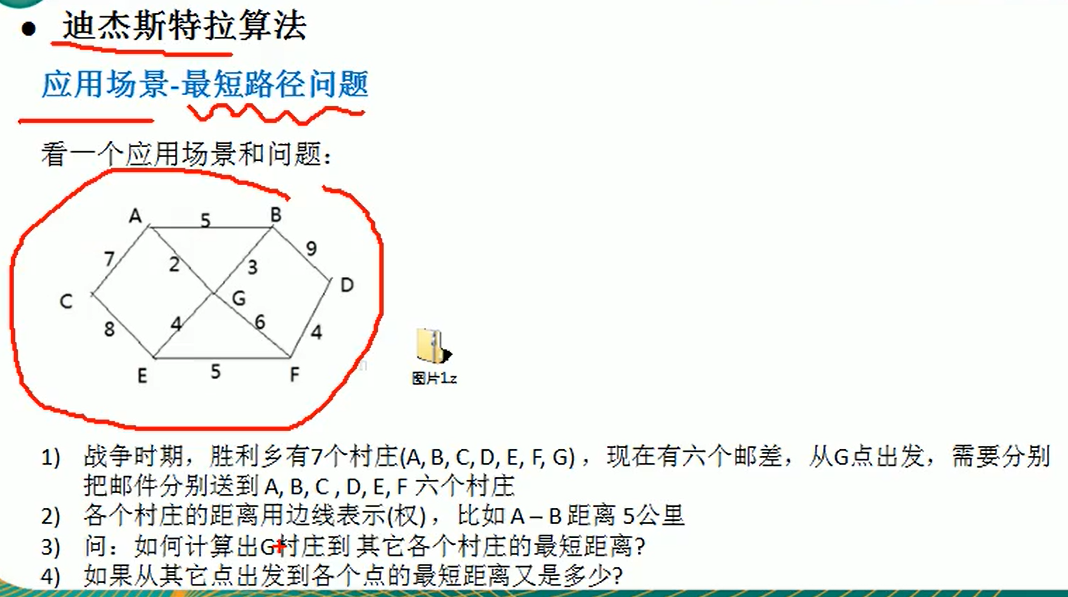
-

-
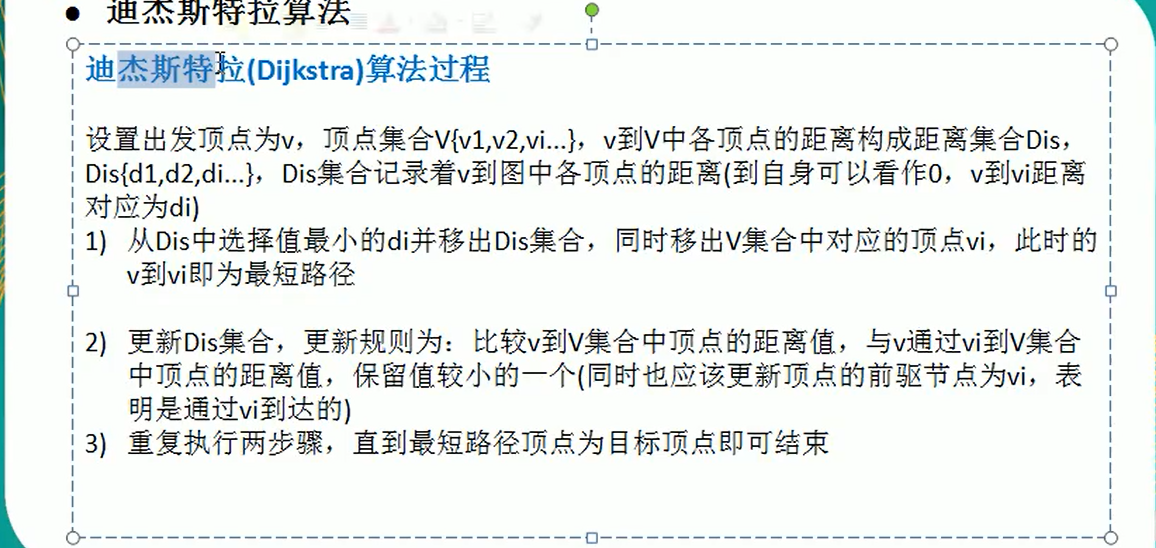
-
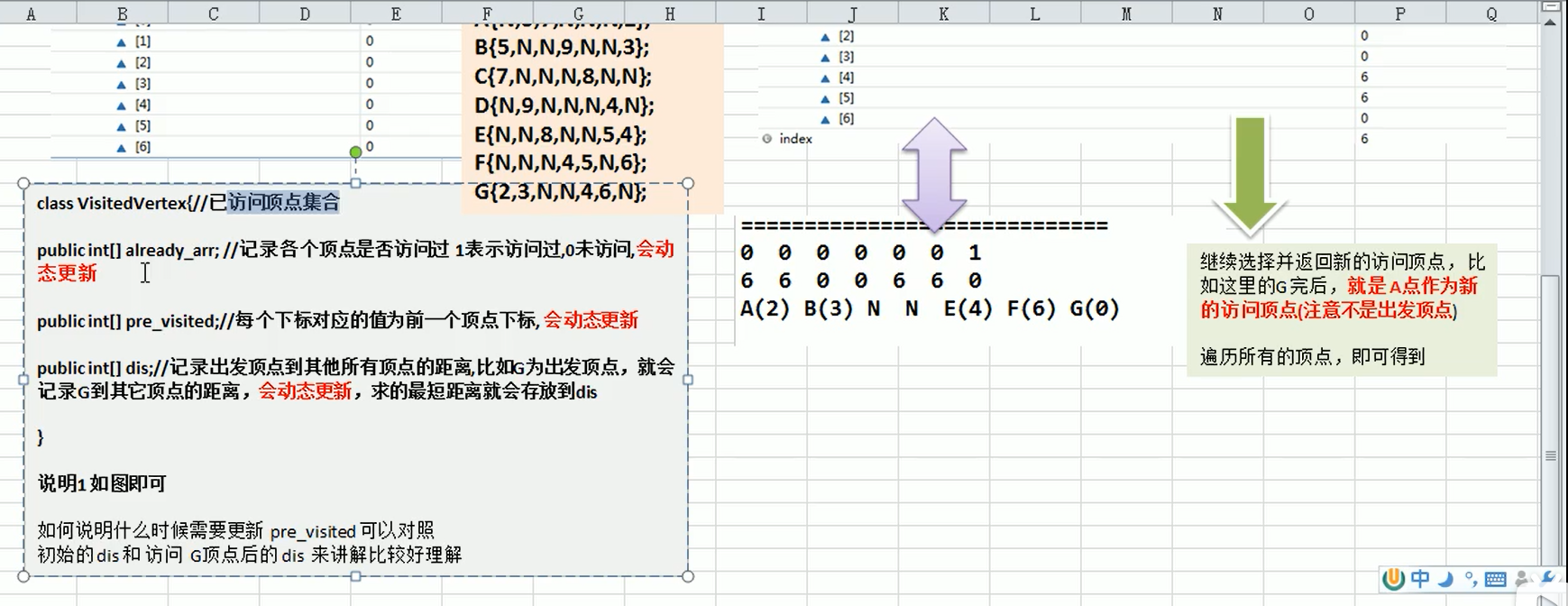
-
package com.model.algorithm; import java.util.Arrays; /** * @Description:测试类 * @Author: 张紫韩 * @Crete 2021/7/20 10:06 * 十种常用算法--迪杰斯特拉算法(Dijkstra) */ public class AlgorithmDemo08 { public static void main(String[] args) { char[] data={'A','B','C','D','E','F','G'}; DijkstraGraph graph = new DijkstraGraph(data); graph.addEdge('A', 'B', 5); graph.addEdge('A', 'C', 7); graph.addEdge('A', 'G', 2); graph.addEdge('B', 'G', 3); graph.addEdge('B', 'D', 9); graph.addEdge('C', 'E', 8); graph.addEdge('D', 'F', 4); graph.addEdge('E', 'F', 5); graph.addEdge('E', 'G', 4); graph.addEdge('F', 'G', 6); // graph.show(); Dijkstra dijkstra = new Dijkstra(graph); dijkstra.show(); System.out.println(Arrays.toString(dijkstra.dis)); System.out.println(Arrays.toString(dijkstra.visited)); System.out.println(Arrays.toString(dijkstra.pre_visited)); dijkstra.dijkstra('A'); dijkstra.showResult(); } } class Dijkstra{ private final DijkstraGraph graph; public int[] visited; //记录每个顶点的访问情况 public int[] pre_visited; //记录每个顶点的前驱节点 public int[] dis;//记录起点到各个顶点的距离 // 核心算法,生成顶点到各个顶点的最短距离 public void dijkstra(char c){ int index = getPosition(c); dis[index]=0;//设置起点到自己的距离为0 for (int i = 0; i < visited.length; i++) { visited[index]=1;//起点为1,已将访问过了 update(index);//跟新起点能到大的节点的信息 index=getNewIndex(); } } // 获得一个新的访问顶点,以这个顶点继续访问其他的顶点 public int getNewIndex(){ int index=0; int min=Integer.MAX_VALUE; for (int i = 0; i < visited.length; i++) { if (dis[i]<min&&!isVisited(i)){ index=i; min=dis[i]; } } return index; } // 更新某个index节点到周围节点的距离以及周围顶点的前驱节点 public void update(int index){ int len=0; for (int i = 0; i < graph.weight[index].length; i++) { len=getDis(index)+graph.weight[index][i]; if (!isVisited(i)&&len<getDis(i)){ updateDis(i, len);//更新距离 updatePre(i, index);//更新前驱节点 } } } // 展示最后的结果 public void showResult(){ System.out.println("每个顶点的访问情况:"+Arrays.toString(visited)); System.out.println("每个顶点的前驱节点情况:"+Arrays.toString(pre_visited)); System.out.println("每个顶点到起点的最短距离情况:"+Arrays.toString(dis)); } // 判断当前节点是否被访问了 public boolean isVisited(int index){ return visited[index]==1; } // 更新起点index到节点的距离 public void updateDis(int end,int len){ dis[end]=len; } // 更新顶点的前前驱节点 public void updatePre(int index,int pre){ pre_visited[index]=pre; } // 返回某个顶点到起点的距离 public int getDis(int index){ return dis[index]; } // 初始化 public Dijkstra(DijkstraGraph graph) { visited=new int[graph.nodeNum]; pre_visited=new int[graph.nodeNum]; dis=new int[graph.nodeNum]; Arrays.fill(dis, Integer.MAX_VALUE); this.graph = graph; } // 返回某个顶点的下标 public int getPosition(char c){ if (graph!=null) { return graph.getPosition(c); }else { return -1; } } // 展示图 public void show(){ if (graph!=null) { graph.show(); }else { System.out.println("图为空"); } } } //图类 class DijkstraGraph { int nodeNum;//节点的数量 char[] data;//存放节点的数据 int[][] weight;//存放边 private static final int INF = 65535; // 返回顶对应的下标 public int getPosition(char c) { for (int i = 0; i < nodeNum; i++) { if (data[i] == c) { return i; } } return -1; } // 初始化 public DijkstraGraph(char[] data) { this.nodeNum = data.length; this.data = data; weight = new int[nodeNum][nodeNum]; for (int i = 0; i < weight.length; i++) { for (int j = 0; j < weight.length; j++) { weight[i][j] = INF; } } } public void addEdge(char nodeA, char nodeB, int weight) { this.weight[getPosition(nodeA)][getPosition(nodeB)] = weight; this.weight[getPosition(nodeB)][getPosition(nodeA)] = weight; } // 展示图 public void show() { for (int[] link : this.weight) { for (int j : link) { System.out.printf("%10d\t", j); } System.out.println(); } } }
-
-
弗洛伊德算法(Floyd):
-
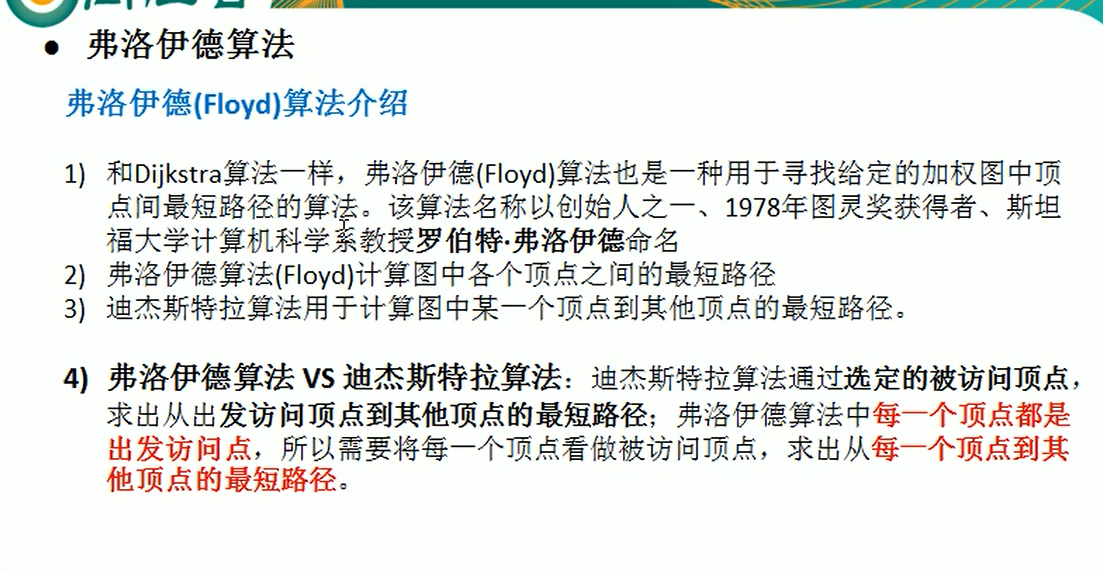
-
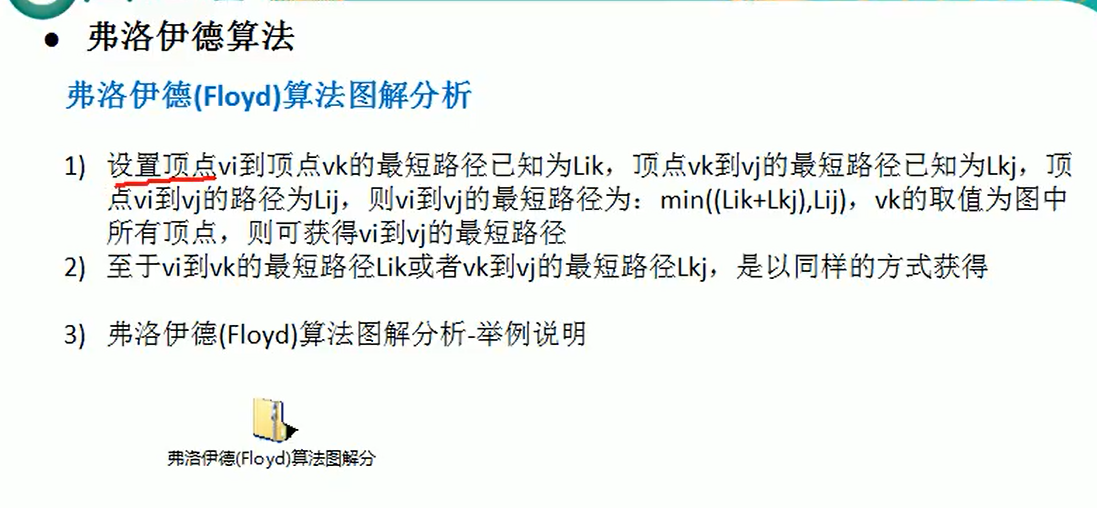
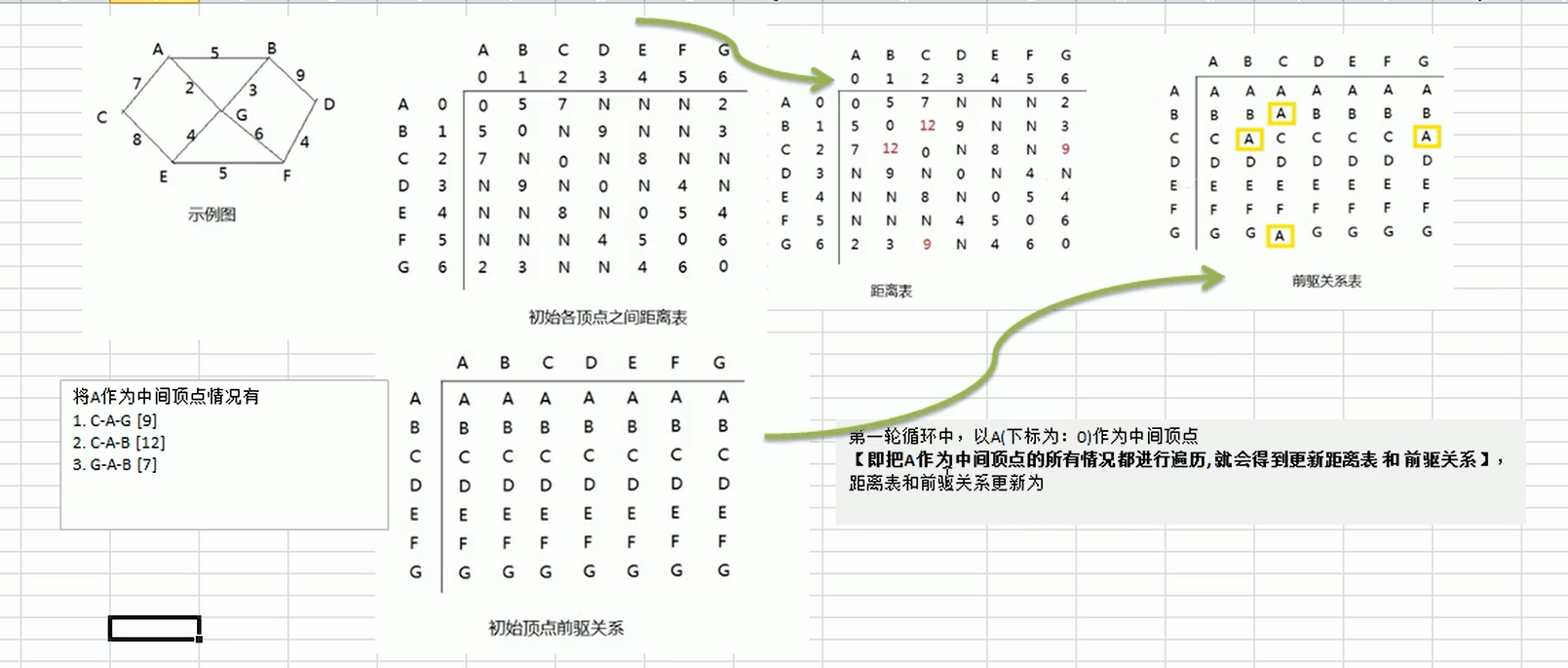
-

-
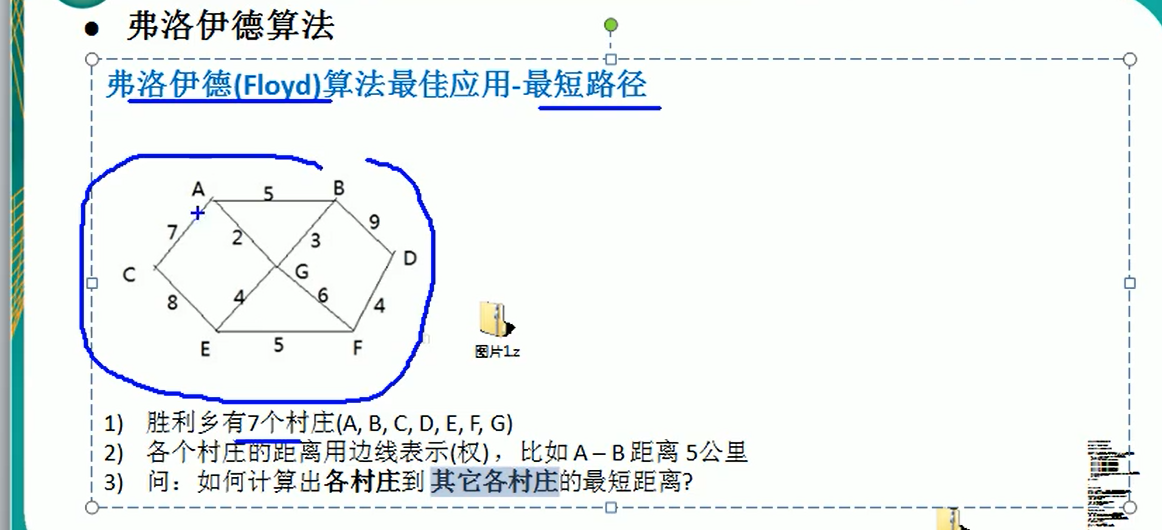
-
package com.model.algorithm; import java.util.Arrays; /** * @Description:测试类 * @Author: 张紫韩 * @Crete 2021/7/20 16:09 * 十种常用算法--弗洛伊德算法(Floyd) * 求最短路径 */ public class AlgorithmDemo09 { public static void main(String[] args) { char[] data={'A','B','C','D','E','F','G'}; FloydGraph graph = new FloydGraph(data); graph.addEdge('A', 'B', 5); graph.addEdge('A', 'C', 7); graph.addEdge('A', 'G', 2); graph.addEdge('B', 'G', 3); graph.addEdge('B', 'D', 9); graph.addEdge('C', 'E', 8); graph.addEdge('D', 'F', 4); graph.addEdge('E', 'F', 5); graph.addEdge('E', 'G', 4); graph.addEdge('F', 'G', 6); // graph.show(); Floyd floyd = new Floyd(graph); floyd.showGraph(); System.out.println("返回节点对应的下标:"+floyd.getPosition('B')); floyd.floyd(); floyd.showResult(); } } class Floyd{ private FloydGraph graph; private int[][] dis;//从各个顶点出发,到达其他的顶点的距离,最后的结果,也保留在这个数组中 private int[][] pre;//保存到目标节点的前驱节点 // 弗洛伊德的核心算法, public void floyd(){ int len=0; for (int i = 0; i < dis.length;i++) {//中间节点,以某个中间节点循环,不断更新 两个节点的前驱节点和两个节点之间的距离 for (int j = 0; j < dis.length; j++) {//起点 for (int k = 0; k < dis.length; k++) {//终点 len=dis[j][i]+dis[i][k]; if (len<dis[j][k]){ dis[j][k]=len;//跟新最小数据 pre[j][k]=pre[k][j];//跟新前驱节点 } } } } } public Floyd(FloydGraph graph) { dis=graph.weight; this.graph = graph; pre=new int[graph.nodeNum][graph.nodeNum]; for (int i = 0; i < pre.length; i++) { Arrays.fill(pre[i],i); } } public void showResult(){ for (int i=0;i< dis.length;i++){ for (int j = 0; j < dis[i].length; j++) { System.out.printf("<"+graph.data[i]+","+graph.data[j]+">最短路径:%5d\t",dis[i][j]); } System.out.println(); for (int j = 0; j < dis[i].length; j++) { System.out.printf("<"+graph.data[i]+","+graph.data[j]+">前驱节点:%5s\t", graph.data[pre[i][j]]); } System.out.println(); System.out.println(); } } public int getPosition(char c){ return graph.getPosition(c); } public void showGraph(){ if (graph!=null){ graph.show(); }else { System.out.println("图为空"); } } } //图类 class FloydGraph { int nodeNum;//节点的数量 char[] data;//存放节点的数据 int[][] weight;//存放边 private static final int INF = 65535; // 返回顶对应的下标 public int getPosition(char c) { for (int i = 0; i < nodeNum; i++) { if (data[i] == c) { return i; } } return -1; } // 初始化 public FloydGraph(char[] data) { this.nodeNum = data.length; this.data = data; weight = new int[nodeNum][nodeNum]; for (int i = 0; i < weight.length; i++) { for (int j = 0; j < weight[i].length; j++) { if (i==j){ weight[i][j]=0; }else { weight[i][j] = INF; } } } } public void addEdge(char nodeA, char nodeB, int weight) { this.weight[getPosition(nodeA)][getPosition(nodeB)] = weight; this.weight[getPosition(nodeB)][getPosition(nodeA)] = weight; } // 展示图 public void show() { for (int[] link : this.weight) { for (int j : link) { System.out.printf("%10d\t", j); } System.out.println(); } } }
-
-
马踏棋盘算法(骑士周游问题):
-
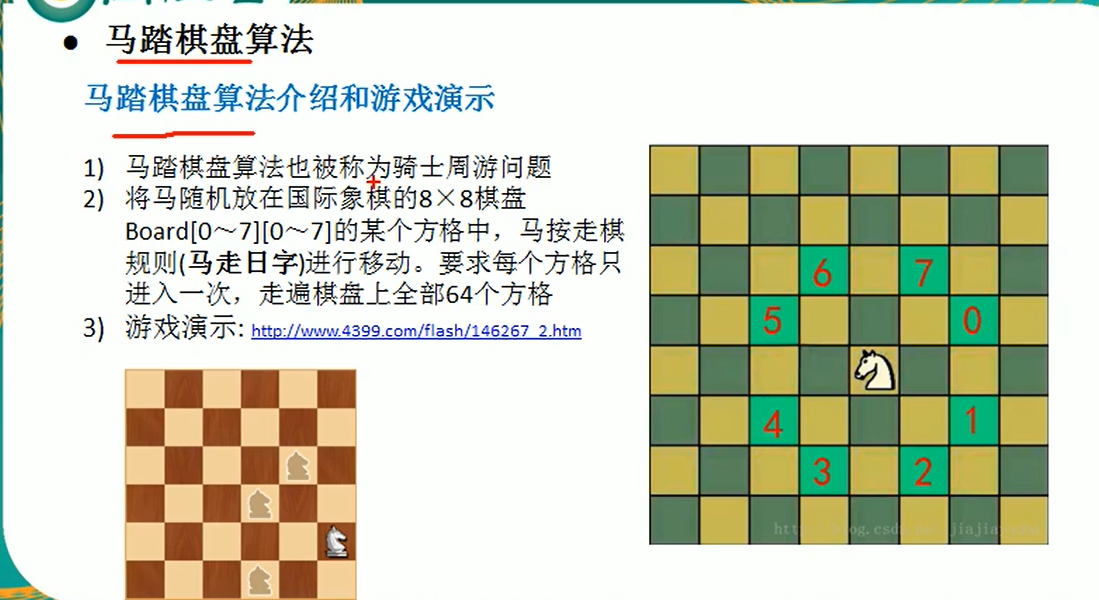
-
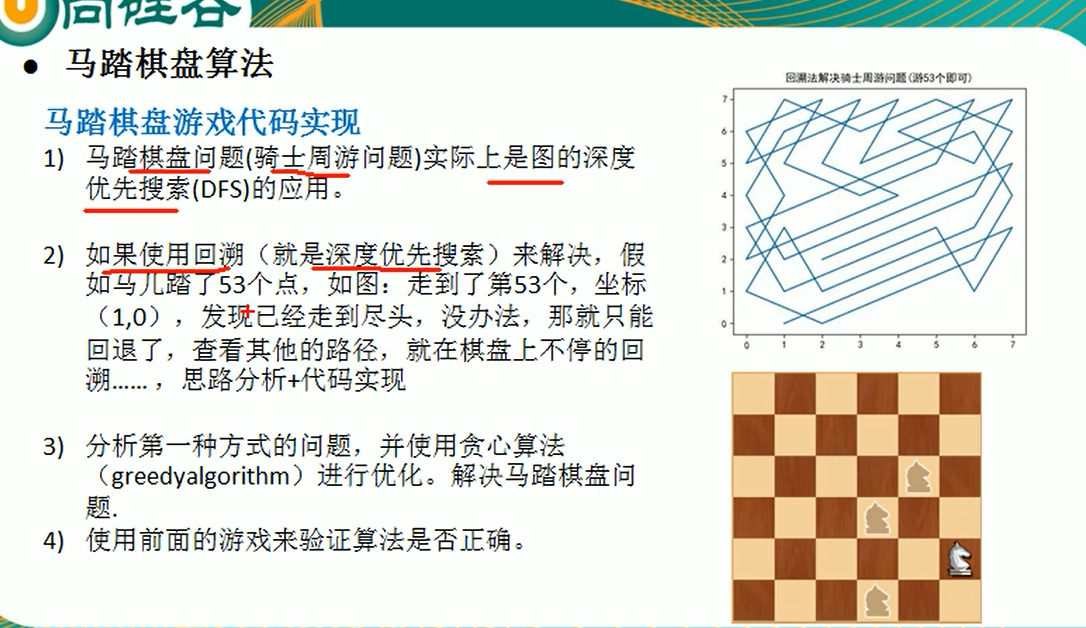
-
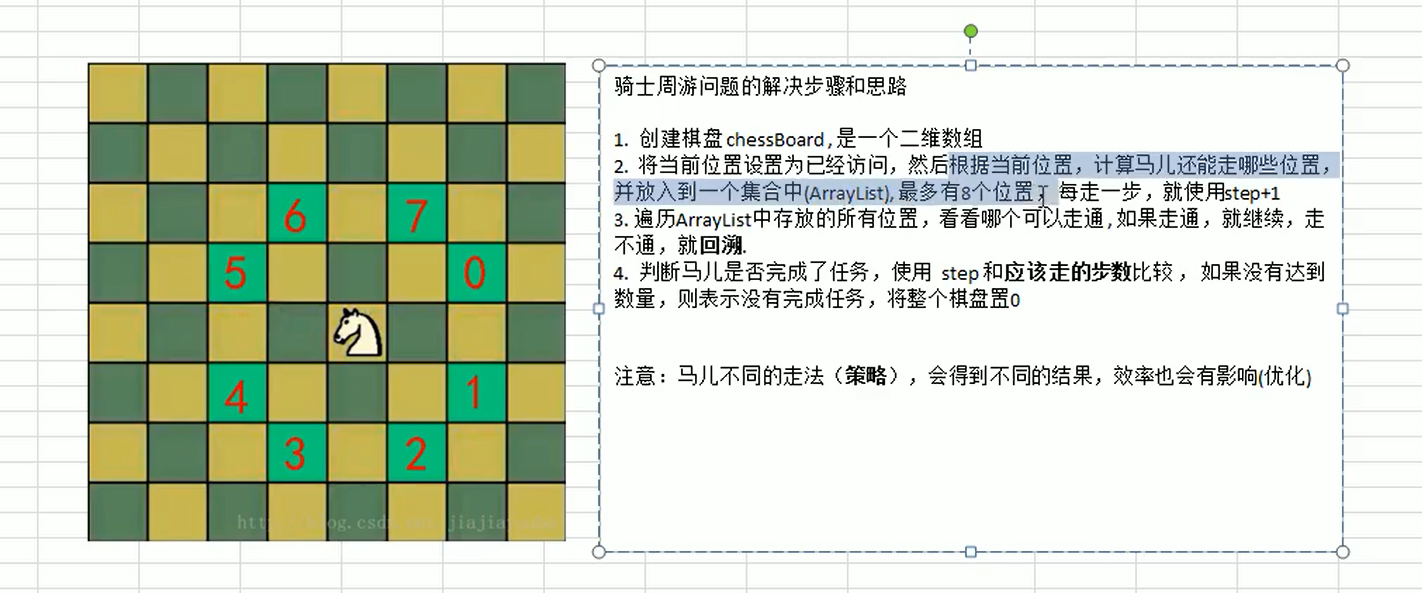
-
package com.model.algorithm; import com.sun.deploy.pings.Pings; import java.awt.*; import java.time.LocalDateTime; import java.util.ArrayList; import java.util.Arrays; import java.util.Comparator; /** * @Description:测试类 * @Author: 张紫韩 * @Crete 2021/7/20 20:22 * 十种常用算法--马踏棋盘算法(骑士周游问题) */ public class AlgorithmDemo10 { public static void main(String[] args) { System.out.println("开始了"); HorseChessboard chessboard = new HorseChessboard(8, 8); int second = LocalDateTime.now().getSecond(); chessboard.horseChessBoard(0, 0, 1); System.out.println("共耗时:"+(LocalDateTime.now().getSecond()-second)); for (int[] temp:chessboard.getChessboard()){ System.out.println(Arrays.toString(temp)); } for (boolean[] temp:chessboard.getVisited()){ System.out.println(Arrays.toString(temp)); } } } class HorseChessboard{ private int x;//第几列 private int y;//第几行 private int[][] chessboard;//棋盘 private boolean[][] visited;//是否访问 private boolean finished=false;//是否完成 public void horseChessBoard(int row,int column,int step){ // 1.假设当前节点是可以遍历整个棋盘的,将当前节点访问, Point curr = new Point(row, column); chessboard[row][column]=step; visited[row][column]=true; // 2.访问节点周围所有的节点 ArrayList<Point> next = getNext(curr); sortPoint(next);//使用贪心算法,先遍历可行数量少的,可以减少回溯的次数,来提高速度 while (!next.isEmpty()){ Point remove = next.remove(0); if (!visited[remove.x][remove.y]) { horseChessBoard(remove.x, remove.y, step+1); } } // 3.实现回溯 // 假设当前节点是可以访问的,如果遍历了这个周围的所有节点,但还是没有走完,就说明这个节点是走不通的我们需要进行回溯 if (step<x*y&&!finished){ chessboard[row][column]=0; visited[row][column]=false; }else { finished=true; } } public ArrayList<Point> getNext(Point curPoint){ ArrayList<Point> nextList = new ArrayList<>(); int x = curPoint.x; int y = curPoint.y; if (x-2>=0&&y-1>=0){//5号位置 nextList.add(new Point(x-2,y-1)); } if (x-1>=0&&y-2>=0){//6好位置 nextList.add(new Point(x-1,y-2)); } if (x+1<this.x&&y-2>=0){//7号位置 nextList.add(new Point(x+1,y-2)); } if (x+2<this.x&&y-1>=0){//0好位置 nextList.add(new Point(x+2,y-1)); } if (x+2<this.x&&y+1<this.y){//1号位置 nextList.add(new Point(x+2,y+1)); } if (x+1<this.x&&y+2<this.y){//2好位置 nextList.add(new Point(x+1,y+2)); } if (x-1>=0&&y+2<this.y){//3好位置 nextList.add(new Point(x-1,y+2)); } if (x-2>=0&&y+1<this.y){//4好位置 nextList.add(new Point(x-2,y+1)); } return nextList; } public void sortPoint(ArrayList<Point> pointList){ pointList.sort(new Comparator<Point>() { @Override public int compare(Point o1, Point o2) { return getNext(o1).size()-getNext(o2).size(); } }); } public HorseChessboard(int x, int y) { visited=new boolean[x][y]; chessboard=new int[x][y]; this.x = x; this.y = y; for (boolean[] temp:visited){ Arrays.fill(temp, false); } } public int getX() { return x; } public void setX(int x) { this.x = x; } public int getY() { return y; } public void setY(int y) { this.y = y; } public int[][] getChessboard() { return chessboard; } public void setChessboard(int[][] chessboard) { this.chessboard = chessboard; } public boolean[][] getVisited() { return visited; } public void setVisited(boolean[][] visited) { this.visited = visited; } public boolean isFinished() { return finished; } public void setFinished(boolean finished) { this.finished = finished; } }
-



